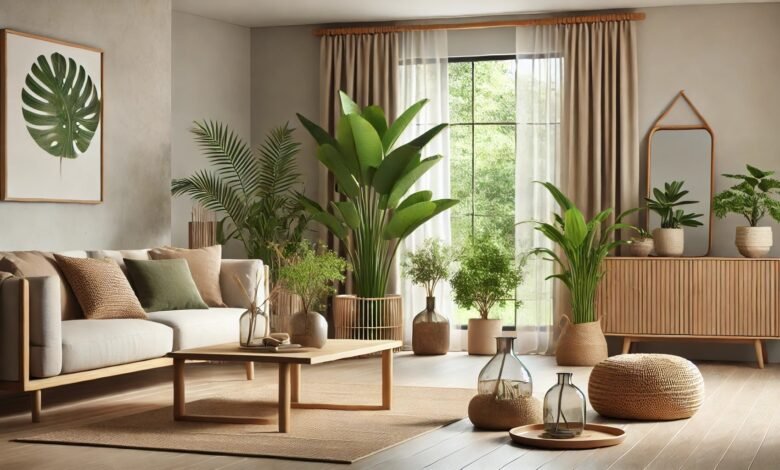Eco-Friendly Home Decor: Sustainable Ways to Style Your Home
In this article, we’ll explore the best sustainable ways to style your home while keeping it chic and elegant.

As people become more conscious of environmental sustainability, eco-friendly home decor has emerged as a growing trend. Decorating your home in an environmentally responsible way not only benefits the planet but also creates a healthier living space for you and your family. From sustainable materials to energy-efficient designs, there are numerous ways to incorporate green decor into your home. In this article, we’ll explore the best sustainable ways to style your home while keeping it chic and elegant.
1. Choose Sustainable Materials
The foundation of eco-friendly home decor is using materials that are renewable, recyclable, and ethically sourced.
Examples of Sustainable Materials:
- Bamboo: A fast-growing, highly renewable resource used for furniture, flooring, and decor items.
- Reclaimed Wood: Repurposed wood from old buildings or furniture that reduces deforestation.
- Cork: A biodegradable and recyclable material perfect for flooring, walls, and accessories.
- Organic Cotton and Linen: Natural, pesticide-free fabrics for upholstery and curtains.
- Recycled Metal and Glass: These materials require less energy to produce and add an industrial-chic touch.
By choosing eco-friendly materials, you reduce the environmental impact of your home while enhancing its aesthetic appeal.
2. Invest in Energy-Efficient Lighting
Lighting plays a crucial role in home decor, and using energy-efficient lighting solutions can significantly lower your carbon footprint.
Eco-Friendly Lighting Options:
- LED Bulbs: Consume 80% less energy than traditional bulbs and last longer.
- Solar-Powered Lights: Ideal for outdoor spaces, reducing electricity usage.
- Smart Lighting Systems: Automate lighting to save energy by controlling brightness and timing.
- Natural Light Optimization: Use large windows, mirrors, and light-colored walls to maximize sunlight.
By adopting energy-efficient lighting, you can create a warm and inviting ambiance while reducing electricity consumption.
3. Use Eco-Friendly Paint and Finishes
Traditional paints contain volatile organic compounds (VOCs) that release harmful chemicals into the air. Eco-friendly alternatives provide a healthier option for home interiors.
Sustainable Paint Options:
- Low-VOC or Zero-VOC Paints: Reduce indoor air pollution and provide a safer environment.
- Natural Paints: Made from clay, chalk, or milk protein, they are biodegradable and non-toxic.
- Recycled Paints: Made from unused surplus paints, reducing waste.
Opting for eco-friendly paint ensures a healthier home without compromising style.
4. Decorate with Indoor Plants
Indoor plants enhance air quality while adding a natural touch to your home decor.
Best Eco-Friendly Plants for Home Decor:
- Snake Plant: Removes toxins from the air and requires minimal maintenance.
- Peace Lily: Helps filter indoor pollutants and adds elegance.
- Spider Plant: Absorbs carbon monoxide and other toxins.
- Aloe Vera: Provides health benefits while acting as a decorative element.
- Fiddle Leaf Fig: Adds greenery and a contemporary feel to any space.
Incorporating indoor plants is a simple yet effective way to enhance your home’s sustainability.
5. Opt for Second-Hand and Vintage Furniture
Buying second-hand or vintage furniture reduces waste and promotes sustainability. Many old furniture pieces have better craftsmanship than modern mass-produced items.
Where to Find Second-Hand Furniture:
- Thrift Stores and Flea Markets
- Online Marketplaces (eBay, Craigslist, Facebook Marketplace)
- Antique Shops
- Refurbished and Upcycled Furniture Stores
Repurposing vintage furniture not only gives your home a unique charm but also keeps items out of landfills.
6. Reduce Waste with Minimalist Design
Minimalism is an excellent approach to sustainable home decor as it emphasizes quality over quantity.
How to Achieve a Minimalist Yet Eco-Friendly Home:
- Declutter and Donate: Keep only necessary items and donate unwanted decor.
- Choose Multifunctional Furniture: Saves space and resources.
- Use Timeless Pieces: Avoid trendy items that go out of style quickly.
A minimalist approach reduces waste and promotes a clutter-free, serene living space.
7. Incorporate Recycled and Upcycled Decor
Recycling and upcycling reduce waste and add a creative touch to home decor.
Ideas for Upcycling Home Decor:
- Old Wooden Crates: Convert them into stylish shelves or storage units.
- Glass Jars: Use them as vases, candle holders, or kitchen storage.
- Repurpose Old Fabrics: Turn them into pillow covers, curtains, or rugs.
- Wine Bottles: Transform them into decorative lighting fixtures or flower vases.
Upcycling promotes sustainability while allowing for personalized home decor.
8. Use Eco-Friendly Rugs and Carpets
Synthetic rugs often contain chemicals that can be harmful to health and the environment. Instead, choose sustainable options.
Best Eco-Friendly Rug Materials:
- Jute: Biodegradable, natural, and durable.
- Wool: Renewable and long-lasting.
- Recycled Plastic Rugs: Made from repurposed plastic waste.
- Organic Cotton Rugs: Soft, chemical-free, and sustainable.
These materials ensure stylish flooring while minimizing environmental impact.
9. Reduce Water Consumption in Home Decor
Water conservation is an essential aspect of sustainable home styling.
How to Reduce Water Usage in Home Decor:
- Low-Flow Faucets and Showerheads: Minimize water waste.
- Rainwater Collection Systems: Use collected rainwater for gardening.
- Drought-Resistant Plants: Require less watering while enhancing outdoor decor.
- Water-Efficient Appliances: Choose dishwashers and washing machines with energy-saving certifications.
Reducing water consumption contributes to a more eco-friendly home.
10. Support Sustainable Brands
When purchasing home decor items, opt for brands that prioritize sustainability.
What to Look for in a Sustainable Brand:
- Ethically Sourced Materials: Ensure fair trade and eco-friendly production.
- Certified Sustainable Products: Look for FSC (Forest Stewardship Council) or OEKO-TEX certifications.
- Handmade and Locally Produced Items: Reduce carbon footprint from transportation.
By supporting sustainable brands, you contribute to a greener economy while styling your home responsibly.
Conclusion
Creating an eco-friendly home is about making mindful choices that benefit both your living space and the planet. By incorporating sustainable materials, energy-efficient designs, and responsible consumption habits, you can style your home in an environmentally conscious way. Whether it’s choosing reclaimed wood, using energy-saving lights, or supporting sustainable brands, every small effort counts. Start your journey toward a greener home today and enjoy a beautiful, eco-conscious living space!











